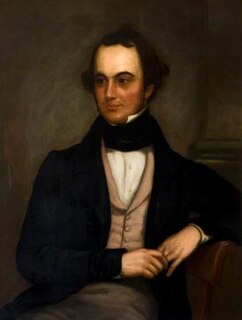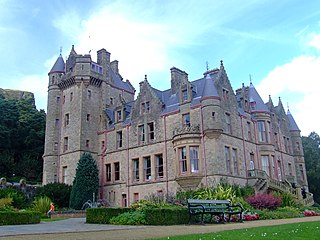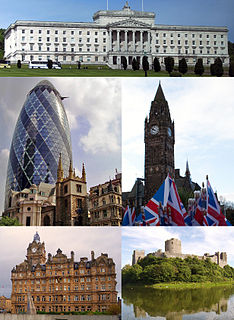
Belfast is the capital and largest city of Northern Ireland, standing on the banks of the River Lagan on the east coast of Northern Ireland. It is the 12th-largest city in the United Kingdom and the second-largest on the island of Ireland. It had a population of 333,871 as of 2015. Belfast suffered greatly in the Troubles: in the 1970s and 1980s it was reported to be one of the world's most dangerous cities, with a homicide rate around 31 per 100,000.

Carrickfergus Castle is a Norman castle in Northern Ireland, situated in the town of Carrickfergus in County Antrim, on the northern shore of Belfast Lough. Besieged in turn by the Scottish, native Irish, English and French, the castle played an important military role until 1928 and remains one of the best preserved medieval structures in Northern Ireland. It was strategically useful, with 3/4 of the castle perimeter surrounded by water. Today it is maintained by the Northern Ireland Environment Agency as a state care historic monument, at grid ref: J4143 8725.

Belfast City Centre is the central business district of Belfast, Northern Ireland.

The Albert Memorial Clock is a clock tower situated at Queen's Square in Belfast, Northern Ireland. It was completed in 1869 and is one of the best known landmarks of Belfast.

Belfast City Hall is the civic building of Belfast City Council located in Donegall Square, Belfast, Northern Ireland. It faces North and effectively divides the commercial and business areas of the city centre.

St Thomas' Church is a church of the Church of Ireland in south Belfast, Northern Ireland. It is located at the end of Eglantine Avenue at the junction with the Lisburn Road and holds regular services. The parish extends from Elmwood Avenue to Adelaide Park, and from the Malone Road to the Lisburn Road.

Sir Charles Lanyon DL, JP was an English architect of the 19th century. His work is most closely associated with Belfast, Northern Ireland.

Belfast Waterfront is a multi-purpose conference and entertainment centre, in Belfast, Northern Ireland, designed by local architects' firm Robinson McIlwaine. Practice partner Peter McGuckin was the project architect.

Stranmillis is an area in south Belfast, Northern Ireland. It is also an electoral ward for Belfast City Council, part of the Laganbank district electoral area. As part of the Queen's Quarter, it is the location for prominent attractions such as the Ulster Museum and Botanic Gardens. The area is located on Stranmillis Road, with Malone Road to the west and the River Lagan to the east. Its name, meaning "the sweet stream" in Irish, refers to the Lagan, whose waters are still fresh at this point, before becoming brackish as the river flows onward toward its mouth in Belfast Lough.

Titanic Quarter in Belfast, Northern Ireland, is a large-scale waterfront regeneration, comprising historic maritime landmarks, film studios, education facilities, apartments, a riverside entertainment district, and the world's largest Titanic-themed attraction centred on land in Belfast Harbour, known until 1995 as Queen's Island. The 185-acre (75 ha) site, previously occupied by part of the Harland and Wolff shipyard, is named after the company's, and the city's, most famous product, RMS Titanic. Titanic Quarter is part of the Dublin-based group, Harcourt Developments, which has held the development rights since 2003.

Queen's Quarter is the southern-most quarter in Belfast, Northern Ireland and named after Queen's University Belfast, Northern Ireland's largest university. The Quarter is centred on the Lanyon Building, the University's most prominent building, designed by architect Sir Charles Lanyon, while Botanic Avenue, Stranmillis Road, University Road and Malone Road are the main thoroughfares through the area. The Quarter encompasses a region bounded by the Ormeau Road, the Holylands and Stranmillis Embankment to the east and the Lisburn Road to the west.

The buildings and structures of Belfast, Northern Ireland comprise many styles of architecture ranging from Edwardian through to state-of-the-art modern buildings like the Waterfront Hall. The city's beautiful Edwardian buildings are notable for their display of a large number of sculptures. Many of Belfast's Victorian landmarks, including the main Lanyon Building at Queens University in 1849, were designed by Sir Charles Lanyon.

William Joseph Barre was a prolific Irish architect who built many well known buildings in Belfast in a Gothic Revival style, but was always overshadowed by his great rival, Charles Lanyon.

William Henry Lynn (1829–1915) was an Irish-born architect with a practice in Belfast and the north of England. He is noted for his Ruskinian Venetian Gothic public buildings, which include Chester Town Hall and Barrow-in-Furness Town Hall.

Great Victoria Street is a railway station serving the city centre of Belfast, Northern Ireland. It is one of two major stations in the city, along with Lanyon Place, and is one of the four stations located in the city centre, the others being Lanyon Place, Botanic and City Hospital. It is situated near Great Victoria Street, one of Belfast's premier commercial zones, and Sandy Row. It is also in a more central position than Lanyon Place, with the Europa Hotel, Grand Opera House and The Crown Liquor Saloon all nearby.

Lanyon, Lynn & Lanyon, Civil Engineers and Architects was a 19th-century firm working mainly in Dublin and Belfast, and the leading architectural firm in Belfast during the 1860s. Its partners were Charles Lanyon, William Henry Lynn, and Charles' son John Lanyon.

The architecture of the United Kingdom, or British architecture, consists of an eclectic combination of architectural styles, ranging from those that predate the creation of the United Kingdom, such as Roman, to 21st century contemporary. England has seen the most influential developments, though Ireland, Scotland, and Wales have each fostered unique styles and played leading roles in the international history of architecture. Although there are prehistoric and classical structures in the United Kingdom, British architectural history effectively begins with the first Anglo-Saxon Christian churches, built soon after Augustine of Canterbury arrived in Great Britain in 597. Norman architecture was built on a vast scale throughout Great Britain and Ireland from the 11th century onwards in the form of castles and churches to help impose Norman authority upon their dominions. English Gothic architecture, which flourished between 1180 until around 1520, was initially imported from France, but quickly developed its own unique qualities.

The North Street Arcade is a 1930s Art Deco shopping arcade in the Cathedral Quarter of Belfast, Northern Ireland. It is the only example of a shopping arcade from this decade in Northern Ireland, and is one of only a handful left in the whole of the UK. A Grade B1 listed building, it has been derelict since a fire in 2004.

















































